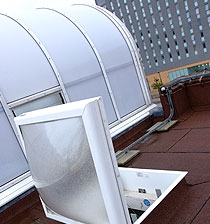Safe access
All flat roofs will have a requirement for a certain amount of pedestrian access, whether this is for maintenance of the roof and any rooftop plant or as a fire escape route. It is therefore necessary to design any flat roof to allow for safe access.
Careful design can eliminate hazards and make the risks associated with roof access easier to manage. Under the CDM Regulations, designers have a duty to ensure that their designs give adequate regard to health and safety. Foreseeable risks should be avoided. If it is not reasonably practicable to avoid them, they should be combated at source. Priority should be given to design solutions providing general rather than individual protection. For example:
Eliminate unprotected fragile materials.
- Minimise inspection and maintenance requirements or the completed roof structure.
- Consider carefully the siting of plant which will require maintenance. Are there alternatives to placing it on the roof? If not, is it in the optimum position on the roof where safe access can most easily be provided?
- When incorporating rooflights, always specify ‘nonfragile’ and consider carefully their location.
- Provide clear and unambiguous specifications for safety critical elements of the design.
- Provide information relevant to maintenance for inclusion in the Health and Safety file.

Rooflights
Where rooflights are used the following should be considered:
1. The specification of rooflights that are ‘non-fragile’.
2. Specifying rooflights that project above the plane of the roof and which cannot be walked on.
3. Specifying rooflights with a design life that matches that of the roof.
Bauder supplies rooflights for use in conjunction with our systems that are classified ‘non-fragile’. These rooflights are guaranteed for the same duration as the roof system that they accompany.
Access to flat roofs is often simple and because they are flat it is easy to walk around on them. Accidents happen not just to roof workers but also to engineers, surveyors, children, and caretakers etc. The first priority is to design out the risk at source; for example, by specifying adequate inbuilt edge protection. Designers should consider the alternatives available in terms of their effectiveness in preventing falls, as well as cost, aesthetics and buildability.
Edge Protection
The options for edge protection in order of effectiveness are:
- Designed parapet
- Guard rail at the roof edge
- Permanent protected walkway for access to plant on the roof
- Preformed sockets to support temporary edge protection guard rails
- Running line systems designed, installed and tested to the relevant standards